

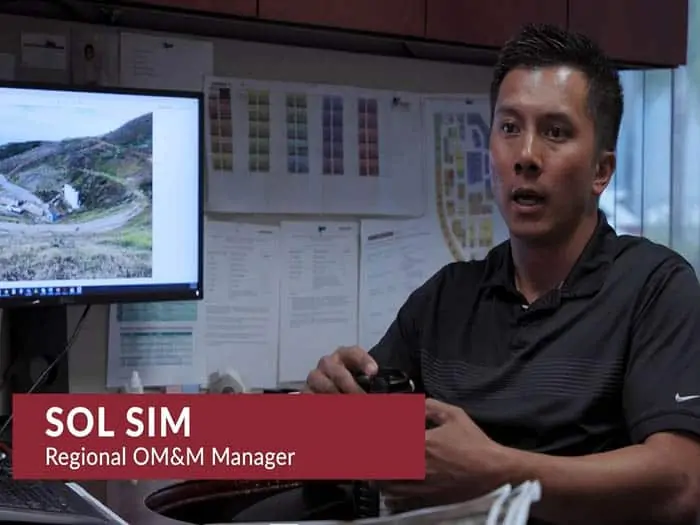
Hydrogen sulfide (H2S) levels are creeping up at some landfills, especially those that take C&D waste; some are seeing concentrations in the thousands to 30,000 parts per million (up from about 20 to 40 ppm ten years ago). And even at very low concentrations, H2S can be problematic.
Material Recovery Facility residuals, which typically contain significant amounts of pulverized drywall, are high in gypsum and sulfate. Once broken down, residuals become a high-surface-area material, leaching into and spreading through waste. When reacting with water and organics, it can potentially generate H2S. With a drive to divert more C&D debris, and regulations tightening around H2S, operators’ jobs get harder as they work to stave off emissions from this corrosive, flammable compound notorious for its “rotten egg” odor.
When building out their gas collection systems, controlling H2S becomes even more daunting. Sol Sim, an SCS Engineers Vice President, explains, “We see H2S concentrations jump when we expand landfill gas collection systems, often in cells that contain C&D residual screening materials. The gas was there all along but sequestered. Now it’s coming out of the ground, and the onset of issues can spike suddenly.”
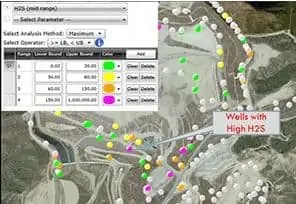
When spikes come on quickly, Sim’s team implements turnkey interim treatment approaches. They start by identifying the gas collection wells with the highest contributors and act fast to get them into compliance.
SCS teams take a two-pronged approach by stepping back and thinking about the big picture while taking action. It provides a major advantage to moving too quickly.
The more data, the better. Your engineers can simulate treatment with various media to assess the impact on flare inlet concentrations. And knowing potential impact at the flare is critical; it’s the compliance point where regulators measure sulfur dioxide (SO2) emissions.
SO2 can’t be controlled through combustion, so removing H2S from waste before sending gas to the flare is essential. Sim thinks back to problems he’s investigated for clients who had SO2 sneak up on them, causing failed sulfur dioxide emissions testing.
The proactive measure of identifying problematic gas wells and treating them is key to staying in compliance. And Sim often finds clients using interim solutions as long as they can. He has seen them work well for up to five years but they don’t resolve operators’ long-term issues, which will become more challenging as our waste streams continue to change or as landfills continue to accept more and more C&D materials.
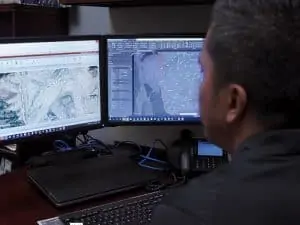
“We’re going to investigate thoroughly to pinpoint and understand the cause, but we do take immediate action in the interim. As part of the solution, we’ll develop an informed strategy to prevent issues well into the future,” he says.
For the longer haul, it takes time to get building permits. Coming up with permanent engineering designs and treatments requires a lot of troubleshooting and research. Even once engineers identify a lasting fix, it takes time to manufacture and install larger vessels and other infrastructure.
But they don’t wait for all these pieces to come together to act.
The priority is getting operators in compliance right away or taking down emissions if they are on the verge of noncompliance. As work begins, operators can breathe a little easier knowing they have time to figure out how to allocate resources and funds to implement a more permanent strategy.
“We’ve seen where data we’ve gathered while working on the immediate problem enables our clients to gain insight to make good decisions around rightsizing their infrastructure moving forward,” Sim says.
Watch and study while addressing the immediate problem.
Sim emphasizes that operators should not be surprised or act too quickly when they turn on the gas extraction system and see spikes in H2S concentrations. There is usually an initial spike from a new high H2S producing area at the onset of gas collection. He has seen operators abruptly stop extracting, which can lead to odors or other compliance issues.
“When you put in a treatment system, you can take out the initial surge in H2S to allow time for the concentrations to level out. It’s important to allow that window for initial surges to run their course to understand the problem better. Otherwise, you could over-design your system around a short-term event,” Sim advises.
He points to a real-life scenario: a site that skipped the interim step of starting with a less expensive initial solution. Once they started drawing on the gas, they realized the problem was not as substantial as originally thought, and they didn’t need a multi-million-dollar system in the end.
A balancing act.
“Imagine H2S generation as an expanding balloon; if you pop it, air rushes out fast [akin to when you first pull gas from the ground]. That concentration level scares people. But if you react by shutting off extraction points, your balloon will continue to expand and eventually create odor problems. The goal is to extract the gas and H2S at the rate it is being generated, so it’s a balancing act, where expertise and technology both play key roles,” Sim says.
Early work typically begins by identifying wells that are the highest contributors and concentrating efforts there. It’s a complex process as sites can have fifty to thousands of collection points. Having the historical data and saving the data to watch the trend makes identifying and analyzing specific wells or clusters much more efficient.
Successfully attacking those high offenders requires an understanding of flow and concentrations. After locating the problem area, Sim takes samples using Dräger tubes at strategic points throughout individual wells and headers to identify concentrations. Gas well monitoring and the corresponding flow data will tell you if you’ve taken emissions down sufficiently.
More Resources:
SCSeTools Landfill Data Monitoring and Analysis
Staying Ahead of Odor Management at Solid Waste Facilities
On September 15, Governor Pritzker signed Senate Bill 2408, forming the Illinois Energy Transition Act. The Act advances renewable energy goals and the path to carbon-free electricity generation by 2045. To say this bill will impact the Illinois electrical utility landscape is an understatement.
Illinois is a top energy producer and consumer in the upper Midwest. The Act requires displacement of more than 6,000 MWh provided from coal and natural gas. One average MWh is enough to power 796 homes for a year in the U.S.
Energy efficiencies and implementing alternative energy resources will be an increasingly important strategy to mitigate the cost impacts from this Act to all users: residential, commercial, industrial, and municipal.
SCS supports clients with the decommissioning and legacy management of coal-fired facilities and renewable energy development. Our environmental team in Illinois includes local experts, Scott Knoepke and Richard Southorn who support the management of coal-fired facilities with Coal Combustion Residuals (CCR) and assist utilities transitioning to renewable natural gas installments and solar energy sources. For coal-fired facilities with CCR impoundments, SCS’s Illinois Office provides design, closure, construction quality assurance, and site stewardship (e.g., long-term maintenance, groundwater monitoring, and reporting).
SCS uses a specialized team for solar implementation on landfills and Brownfields. Knoepke and Southorn are supported by SCS National Experts in the region to assess and implement Solar Energy on Landfills & Brownfields.
The Act defines that landfill gas produced in Illinois as a renewable energy resource. SCS Engineers has one of the longest and most successful Biogas practices in the United States. SCS designs, constructs, and operates more Biogas, Anaerobic Digestion, Renewable Natural Gas, Ag Digester systems than any other engineering firm in the nation. Our clients attribute our quality and high production rates to our practice specializing in waste gas utilization, combined with our expertise in solid waste management and compliance.
New Chicago office location at 40 Shuman Boulevard, Suite 216, Naperville, IL 60563
SCS Engineers continues expanding its environmental team in its Chicago, Illinois office to meet environmental engineering and consulting needs focusing on waste management and the needs of the electric utilities. Driving demands are industries and municipalities seeking to reduce their environmental footprint while providing essential services and products.

Meet the Crew!

Brett Miller is a Senior Designer with over 20 years of experience and proficiency in AutoCAD Civil 3D and Maya. Brett is capable of any production drafting and is highly skilled in understanding 3D space. This helps him support designs that fit into site-specific, real-world environments. Brett also creates 3D models and animations that illustrate the benefits of a design to our clients.
Niko Villanueva, PE, joins SCS with eight years of experience. Niko provides engineering and drafting support and is experienced in designing various landfill systems such as stormwater management, leachate and gas control, and foundation analysis. He has also prepared cost estimates and construction bid quantities for various projects and construction quality assurance services at multiple facilities.


Most everyone is familiar with IIAR2, the American National Standard for Safe Design of Closed-Circuit Ammonia Refrigeration Systems. They will refer to it as the Recognized and Generally Accepted Good Engineering Practice (RAGAGEP) for our industry.
People often forget that IIAR2 is merely the RAGAGEP for the design of ammonia refrigeration systems, but not the installation. IIAR4-2020 is the current RAGAGEP for the installation of ammonia refrigeration systems. If we look through IIAR4, we find that it does, in fact, prohibit the practice of using sheet metal screws when installing insulation.
Section 8.1.11 states, “Screws, rivets, or any other jacket securement device that could pierce the underlying vapor retarder shall not be used. Only bands and seals shall be used to secure the jacketing.”
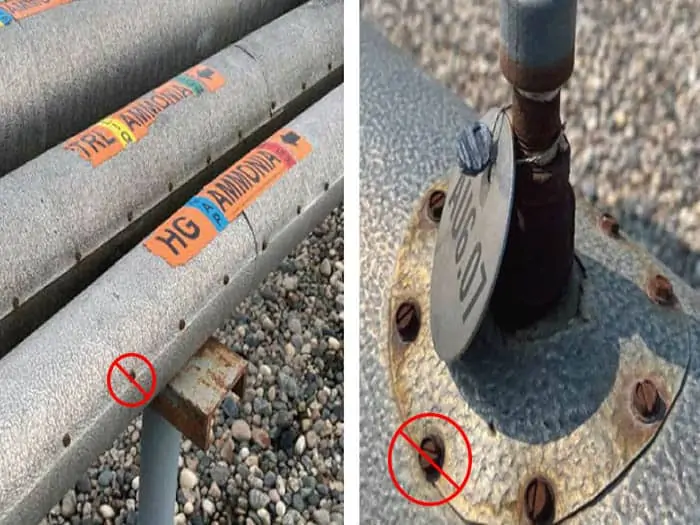
Approved
The EPA issued a newly approved alternative test method (ALT-143) for compliance with the enhanced monitoring provisions in the National Emission Standards for Hazardous Air Pollutants (NESHAPs) for MSW Landfills (40 CFR 63 Subpart AAAA updated March 26, 2020). The approved alternative method instead of Method 10 allows for direct monitoring of CO at a landfill gas well using a portable gas analyzer. The NESHAP requires weekly monitoring of CO at the landfill gas well if the gas temperature is over 145F and the regulatory agency has approved no higher operating value under the NSPS/EG rules or NESHAPs. The Solid Waste Working Group (SWWG) coordinated with landfill gas meter manufacturers (QED, Elkins Earthworks) to prepare this method.
EIL approved sharing a flow chart and Excel file that can be used for monitoring/documentation purposes when using this approved alternative “field instrument method.” Don’t hesitate to get in touch with your SCS air emissions/compliance expert or contact us at for details.
EPA will post the alternative test method to the Broadly Applicable Approved Alternative Test Methods | US EPA website page. Take note that the hyperlink in EPA’s letter is out of date.
Pending Approval
The Solid Waste Working Group (SWWG) also submitted two alternative methods in lieu of Method 10 to EPA for approval using grab sample (canister, foil bag) and laboratory analysis, one with GC/FID and the other GC/TCD instrumentation. The SWWG coordinated with several national laboratories on the methods. EPA is completing its review of the two proposed methods, anticipating EPA approval before September 27, 2021, the effective date of the enhanced monitoring provisions.

Jonathan Meronek specializes in comprehensive stormwater management programs. He has conducted BMP and Pollutant Source Assessments (PSAs), written Stormwater Pollution Prevention Plans (SWPPPs), performed Training and Education classes and implemented Monitoring Implementation Plans (MIPs) for hundreds of facilities in the United States. His accreditations include IGP-TOR, QISP, ENV-SP, CPESC, QSP/D, with over eighteen years of supporting clients at SCS Engineers. As a State of California Industrial General Permit (IGP) Qualified Industrial Storm Water Practitioner (QISP) and QISP Trainer-of-Record (ToR), he finds stormwater solutions for a multitude of industrial clients.
When Endeavor Media (Stormwater Magazine, Wastewater Mag, and Water World) decided to launch their new education platform called “Stormwater University,” they reached out to Jonathan. He now has the good fortune of being one of twelve people to sit on Endeavor’s National Technical Advisory Board.
Jonathan is excited and looks forward to supporting his colleagues in stormwater management. He has promised not to add another post-nominal after his name.
Progressive energy companies are rushing to corner the growing hydrogen market, excited as they see this renewable fuel’s cost steadily drop and as they prioritize decarbonization.
As they work to stay ahead of the pack, they need to put time and thought into building out and implementing these projects. There are complex technical and regulatory considerations; safety is also priority one at every step when managing this flammable, compressed gas.
As the market takes off, there is a need for scaled development along the whole supply chain, and some developers are rising to the occasion for more control and more opportunity. Rather than only build fueling stations, they buy into vertically integrated hydrogen networks to produce, transport and distribute hydrogen. But these multifaceted projects present even more complexity— calling for a team with highly specialized, comprehensive skill sets.
SCS Engineers supports energy companies and contractors looking to diversify their hydrogen services portfolio to include building production plants, including moving the gas via pipeline or truck to offload at fueling stations, ultimately selling to consumers.
“We enter these strategic partnerships to give our clients what they are looking for: a full spectrum of competencies and services; and a proven history of working on hydrogen to deliver turnkey projects. The idea is to take the environmental burden off clients as they pursue these major undertakings,” says Nathan Eady, an SCS vice president, and project manager.
SCS makes site selection; performs environmental due diligence and remediation; feasibility analysis; design and construction of environmental controls; land use, air, and water quality permitting.
The contractors’ specializations are detailed design, engineering, and construction management–from civil to structural to mechanical and fire protection.
This team meets all environmental and regulatory design requirements and develops process safety management and risk management plans with their combined expertise. They also take on the role of community educator, explaining the unique attributes of hydrogen and easing any concerns.
“We take science and engineering and translate that for neighbors and city councils. It’s important to show communities, as well as regulators, that these facilities are designed and operated with the utmost safety,” Eady says.
Requirements vary from jurisdiction to jurisdiction. But with a national reach, SCS sails through processes and regulations by region.
“That matters to our clients; they want to get through the detailed permitting steps and launch as soon as they can to maintain their competitive edge. And when they plan to expand into other regions, they like to know they already have a vetted team in place who knows the territory and can do the work there,” he says.
Permitting and technical considerations vary by location and production method, whether via steam methane reforming (SMR) or electrolysis.

Some operators are taken off-guard by the air quality permitting requirements associated with SMR facilities − or the stringent wildlife and water quality regulations encountered with the larger footprint photovoltaic systems requiring open space to support electrolysis. SCS has the expertise to address the issues, whether state-specific cap and trade regulations for carbon emissions or air basin specific criteria pollutants. SCS also has the unique talent of finding brownfield sites or closed landfill properties, making excellent receiver sites for electrolysis and solar facilities near existing infrastructure.
Building hydrogen projects on these idle properties can save developers significant time and money in the overall project outcome.
“We do a lot of brownfield work helping to clean and redevelop these properties. These sites have special permitting considerations, especially since they typically have a history of industrial use,” Eady says.
SCS performs Phase I Assessments to research records on previous use, and if the team finds a potential problem, they move to Phase II, which entails groundwater and soil testing.
“If we find evidence of existing contamination, we reconcile it so our clients can move forward with the development of their new facilities,” Eady says.
SCS is seeing a growing interest in building hydrogen projects on closed landfills. As brownfields, they have value for their open space and often have some existing infrastructure, offsetting the cost of building new.
“We have done permitting and design work on several closed landfills, sometimes adding solar systems. Hydrogen projects leveraging electrolysis require a tremendous amount of electricity, and when we can bypass the grid enabling clients to make their own electricity, it’s a major plus,” Eady says.
Lately, large energy companies are pivoting from conventional oil and gas to hydrogen, and some smaller, young companies are also joining the clean renewables movement.
SCS has gotten interest from startups looking to obtain government grants and subsidies. Some of these firms need more process engineering support to ensure their new technology can operate at a cost and environmental efficacy equivalent to larger operations.
“We use our knowledge gained working with major conventional energy companies to support these new hydrogen firms in executing successful launches. All in all, a positive trend.”
Together, SCS and its partners play an integral role in helping to see hydrogen continue to climb the energy sector ranks, maintaining an excellent record of accomplishment supporting the planning-design-build of clean-energy plants.
Additional Resources
Landfill operators forever work to stay on top of a diverse and complex mix of leachate contaminants—heavy metals, ammonia, and biochemical oxygen demand, among them. But lately, they have more to think about, for one: how to keep concentrations of these contaminants within the wastewater treatment plant’s tightening discharge limits. Add to this concern the possibility of more compliance pressure as the list of constituents on regulators’ radar grows. Some operators are preparing for what may be down the pike, from microplastics to PFAS and PFOA—with the latter sometimes called the “elephant in the room.”
Among the strategies, some are exploring on-site leachate treatment options, and there are several. Finding the most fitting, sustainable, and cost-effective one takes vetting. Here is the study of a Florida landfill’s informed decision-making process.
A landfill serving an exploding residential and commercial population recently found itself in a predicament when the overburdened municipal wastewater treatment plant stopped accepting leachate from all county waste operations. Pressed to find a credentialed treatment facility quickly, this SCS Engineers client contracted with a private plant, but the arrangement came with a steep price tag. Overnight, the site’s leachate hauling and disposal costs rocketed from just over three cents a gallon to almost 16 cents a gallon. So, the operator turned to SCS Engineers for help vetting a robust and financially sustainable solution. Ultimately, the client wants to eliminate dependence on a third party and better control its destiny to avoid landing in the same predicament.
In answer, SCS is looking into the feasibility of a system that would clean leachate to drinking water standards to be discharged directly to groundwater. The team is wrapping up a comprehensive study of the site’s current operations, system, and leachate composition as it prepares the client to go out to bid.
“Our goal is to position the landfill to be as independent as possible while providing a cost-effective solution to their leachate treatment,” says SCS Engineers Project Lead Kollan Spradlin. He and the SCS liquid management experts backing him have kicked into high gear because time is money. Right now, the landfill generates about 70,000 gallons a day of leachate through much of the year. In the wet season, that figure spikes to about 150,000 gallons a day. At roughly 16 cents, the landfill can shell out over $24,000 a day for leachate disposal during the wet season.
SCS Engineers’ preliminary work begins with compiling crucial information around current leachate generation and future projections and around site-specific characteristics of the liquids. Next, the team vets multiple leachate treatment systems, sizing up each one against the client’s individual needs to ultimately make a recommendation. And, as important, the team makes sure the operator is very clear on how much upfront capital they need to build an effective, reliable system to do the job.
Spradlin and SCS’s liquid management experts are working on an interim solution while developing a long-term plan. The interim remedy is an evaporator fueled by landfill gas, heats and evaporates water molecules.
“With the evaporator, our client’s private disposal volume is reduced by 50,000 gallons a day, significantly cutting disposal costs. But that’s not enough. We want to reduce that expense further and to manage all or the vast majority of the leachate on-site,” Spradlin says.
The ultimate plan is to design a plant that can treat almost 120,000 gallons a day to a quality that can discharge across a spray field at the facility to groundwater. The landfill saves on disposal costs and owns the system rather than paying for an outside operator’s treatment technology.
This Florida landfill relies on SCS’s site knowledge and its past liquids management experience. SCS’ understanding of the systems and daily operations helped the team develop operational measures already reducing leachate generation to make on-site treatment an option.
“We have completed plan design and construction of their collection, storage, treatment, and disposal systems. And that helped to provide insight into reliable, long-term leachate disposal recommendations,” says Bob Gardner, a 41-year veteran of SCS and part of the team supporting this particular project.
“We had knowledge of site fill sequencing, site conditions, and constraints. And this sped up the process of coming up with a modification that works within their operations and infrastructure,” he says.
All of this foundational background is key to identifying client-centered solutions and presenting a comprehensive data package to vendors. “We give bidders the details they need so they can size their equipment appropriately and provide a more accurate budget estimate. We are trying to eliminate bidder change orders resulting from inadequate background information,” Spradlin says.
The team is thinking ahead, evaluating treatment processes that address a wide range of leachate properties and consider constituents that may be regulated in the future.
“We may put in a reverse osmosis system, a membrane bioreactor, or ultrafiltration to reduce constituent concentrations and take out particulates. We design for flexibility to add more treatment technology on the front end or back end to save the client infrastructure costs in years to come,” Spradlin says.
What differentiates SCS from some other environmental engineering firms is its full-service model and deep bench.
“We touch everything at this landfill. And we have a multidisciplinary team, including national liquid management experts whose knowledge we can tap into at any time. So, we can be one-stop, saving the client from having to go to multiple vendors,” Spradlin says.
Sam Cooke is the lead liquid management expert for this Florida landfill. Like his colleague, Gardner, he knows the wastewater treatment problems landfill operators face; he knows the vendors and their technology. And he understands the importance of relationships—with the client, the state agencies, and every party who is key to the client’s success and the community they serve.
“We fully realize that the wastewater-leachate treatment system we design needs to do its job close to 24/7/365. Moreover, it must do it effectively, sometimes under difficult conditions. So, as we design treatment systems and work with equipment suppliers, facility owners, environmental managers, and treatment system operators, we strive to provide added value and support,” Cooke says.
“In this case, we’re using our knowledge to help our client develop a bid package that addresses specific technical requirements but also meets and helps protect their business and financial goals.”
The team has already met with the regulatory agencies to develop a clear permitting path to accelerate plant deployment and ensure the landfill is fully compliant before making the large transition to direct discharge.
By working with vendors and regulatory representatives well before releasing bid documents, SCS has paved a path to leachate treatment independence.
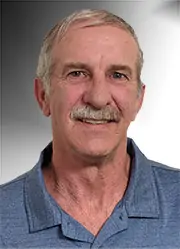
Meet RETA Authorized Instructor (RAI) Daryl Davis. Davis joins the SCS Tracer Environmental training team providing ammonia refrigeration safety, Risk Management Plans, and Process Safety Management certified training.
This SCS team offers comprehensive programs including Ammonia Refrigeration Operator Classes, RETA Certification Review Classes, PSM/RMP & General Duty Clause Safety & Compliance Classes for Ammonia Refrigeration Facilities, Continuing Education, & Custom Training Classes.
SCS’s RAI’s have over 56 combined years of industrial refrigeration expertise. Our trainers use an online delivery system with a live instructor, or on-site, in-person classes, to ensure you continue training for Process Safety Management & Risk Management Program compliance. Hands-on site training can now take place under even noisy plant conditions using high-tech headsets.
RAI – RETA Authorized Instructors have certifications in their mastery teaching advanced refrigeration system concepts and operations at a level that qualifies them to assist CARO, CIRO, CRST, and CRES candidates with their preparations and activities required to earn RETA credentials.
Get the latest in RETA certified training news and classes. The Refrigerating Engineers and Technicians Association (RETA) is the most recognized organization in the U.S. dedicated to the professional development of industrial refrigeration operators and technicians.
Popular Mechanics recently published an article entitled The Pungent History of America’s Garbage Mountains. The article starts with a little-known ferryman on Lake Michigan when a storm beached his craft on an offshore sandbar in July 1886. Thus started Chicago’s open dump on today’s Lake Shore Drive, home to landmarks such as the Museum of Contemporary Art, the Wrigley Building, the Chicago Tribune Tower, Northwestern University, and the Magnificent Mile – all on turn-of-the-century garbage.
Transportation centers, stadiums, and even entire neighborhoods are now built on landfills. This is a fascinating, well-written article on the history and possibilities of building on remediated properties and brownfields.
“Landfill redevelopment projects tend to be real estate projects, and you know what matters in real estate: location, location, location,” says Mike McLaughlin of SCS Engineers, who specializes in brownfields and landfill redevelopment. “A landfill in an urban area might be the only piece of open land in that area. People go to extraordinary lengths to redevelop because the property is so valuable.”